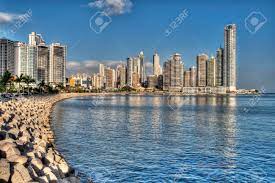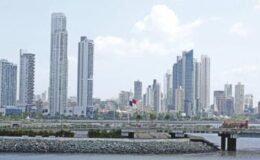Interesting look into Panama bay growth.
- By : James Bryson
- Category : Economy, Hotels, Infrastructure, Panama Tourism

A visible retrospective of Panamanian growth over the years.
https://www.laestrella.com.pa/nacional/220219/transformacion-frente-costero-ciudad-panama
The vertiginous process of transformation of the sea front of Panama City has been characterized by legal controversies, regarding the legality or not of transferring as private property, the filling of areas such as the seabed, mangroves and beaches.

The transformation of the waterfront has been one of the most characteristic features of Panama City since the beginning of the 20th century.
With the construction of the Canal between 1904 and 1914, the seafront underwent important changes. The old mouth of the Grande and Curundú rivers was filled in, on which the towns of Albrook, Curundú, Diablo and Balboa would be built. The Amador landfill and the causeway that linked it with the islands of Pericos, Naos and Flamenco were created. During this same period, the landfills appear on which the Chinatown was built, in Santa Ana and Barraza, in El Chorrillo.
Later, with the construction of the neighborhood of La Exposición, in 1916, the old mangroves and swamps that made up these farms were also filled in, and land was reclaimed from the sea for the construction of the disappeared Anayansi park and the site where the monument to Balboa.
In the 1950s, the construction of Avenida Balboa occurs, with which some of the beaches that were on the sea front disappear.

In 1956 the concession was granted for the construction of the landfill that would occupy the Yacht and Fishing Club.
For the 1970s, we have the fill that was generated for the construction of the Atlapa Convention Center.
This process of transformation of the Panama City waterfront took on a greater boom as of the end of the 1990s, with the contract signed between ICA Panama SA and the State, for the construction of the South Corridor, the real estate boom and the expansion of the Canal, in the mid-2000s.
During this period, the fills corresponding to what is currently Punta Pacifica (1999), the Figali marina (2006-2009), the Coastal Belt I, II and III (2009-2014), the Punta Pacifica Islands (2012-2020), landfills for commercial development and marinas in the islands of Naos, Perico and Flamenco (2003-2010), the expansion of the Amador Causeway (2017), the Cruise Port (2019-2022) and finally , the road interconnection between the Cinta Costera III and Amador, whose construction began this year.

The bottom of the sea, the bottom of the matter
The vertiginous process of transforming the sea front of Panama City has been characterized by legal controversies, regarding the legality or not of transferring as private property, the filling of areas such as the bottom of the sea, mangroves and beaches, which according to Article 258 of the Political Constitution, belong to the public domain.
In this sense, there are two positions expressed in decisions of the Supreme Court of Justice. On the one hand, the ruling of December 26, 2017, regarding the unconstitutionality action against the first and second articles of Cabinet Resolution 57 of October 17, 2000, by which a 17.9-hectare plot of land was disaffected , to transfer them in favor of ICA Panamá, SA
In this ruling, the plenary of the Supreme Court considered that “the act has been issued by a competent authority for that purpose, in accordance with article 200 number 3 of the Constitution, through the corresponding procedure, (…) and prior estimation and verification as to whether any public interest weighed on such an area”.
In addition, it was indicated that, “housing and horizontal property buildings have been built on the farm in question. Thus, if the request of the plaintiff is granted, the State could be faced with having to compensate (…) those who have intervened in good faith in the construction and acquisition of such properties.”
In the claims of unconstitutionality against the first, second, and third articles of Cabinet Resolution 38 of May 5, 2004, and in a subsequent claim of unconstitutionality against the first, second, and third articles of Cabinet Resolution 58 of May 17, October 2000, the Plenum of the Supreme Court took a turn in its assessment of this issue.
In these rulings, the Plenary of the Supreme Court indicates that the assets could not be disaffected by the Executive through a lower level rule, such as a cabinet resolution, so the act is invalidated because it considers that for such disaffection a normative development is required that must be carried out from the National Assembly.
The Supreme Court emphasizes that, “with the ruling that is now being issued, what is intended are rigid and precise controls to preserve the national heritage, and not allow what belongs to everyone to be easily delivered to an individual, thus affecting the community”.
The ruling published in December 2020 concludes that, “one of the situations that eloquently illustrates the need not to leave the dispossession of public domain assets to the whim of the State is precisely the fact that entire sections of the allegations presented by The MOP coincide, on occasions, word for word with those of the forensic firms that, although they have appeared in this process acting on their own behalf, represent, as is widely known, the private beneficiaries of the contested resolution and the contract of concession under whose protection it was issued”.
The condition of legal insecurity of the properties built on these landfills becomes more complex if we take into account the unconstitutionality action against Law 31 of June 18, 2010, which allowed incorporating into the horizontal property regime, “the buildings or projects built on land owned by one or more persons, or given in concessions”.
In this ruling of December 2013, the Supreme Court considers that the phrase “given in concession” is unconstitutional, since it is not possible to submit goods given in concessions to the horizontal property regime, since being a form of private property, this would prevent said assets from subsequently reverting to the State, which violates article 258 of the constitutional text.
The generation of urban land, on the seafront, has been based on tools such as administrative concessions and seabed fills, without the existence of an urban planning instrument to guide the occupation of the seafront in Panama City .
Therefore, it is urgent to develop a normative framework that orders and provides legal certainty to all the transformations that have occurred and that also projects the necessary regulations to regulate urban growth in the face of threats such as the expected rise in sea level, in an orderly manner and ensuring the preservation of the common interest over the individual, as mandated by the Constitution and reaffirmed by the rulings of the Supreme Court of Justice.



No Comments